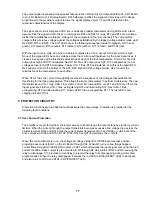
2
1. Parts that have special safety characteristics are identified by the symbol on
schematics or by special notes on the parts list. Use only replacement parts that have
critical characteristics recommended by the manufacturer.
2. Make leakage current or resistance measurements to determine that exposed parts
are acceptably insulated from the supply circuit before returning the unit to the
customer. Use the following checks to perform these measurements:
A. Leakage Current Hot Check-With the unit completely reassembled, plug the AC
line cord directly into a 120V AC outlet. (Do not use an isolation transformer during
this test.) Use a leakage current tester or a metering system that complies with
American National Standards Institute (ANSI) C101.1 "Leakage Current for Appli-
ances" and Underwriters Laboratories (UL) 1492 (71). With the unit AC switch first in
the ON position and then in OFF position, measure from a known earth ground
(metal waterpipe, conduit, etc.) to all exposed metal parts of the unit (antennas,
handle bracket, metal cabinet, screwheads, metallic overlays, control shafts, etc.),
especially any exposed metal parts that offer an electrical return path to the chassis.
Any current measured must not exceed 0.5 milliamp. Reverse the unit power cord
plug in the outlet and repeat test. ANY MEASUREMENTS NOT WITHIN THE LIM-
ITS SPECIFIED HEREIN INDICATE A POTENTIAL SHOCK HAZARD THAT MUST
BE ELIMINATED BEFORE RETURNING THE UNIT TO THE CUSTOMER.
B. Insulation Resistance Test Cold Check-(1) Unplug the power supply and con-
nect a jumper wire between the two prongs of the plug. (2) Turn on the power switch
of the unit. (3) Measure the resistance with an ohmmeter between the jumpered AC
plug and each exposed metallic cabinet part on the unit. When the exposed metallic
part has a return path to the chassis, the reading should be between 1 and 5.2
Megohms. When there is no return path to the chassis, the reading must be "infi-
nite". If it is not within the limits specified, there is the possibility of a shock hazard,
and the unit must be repaired and rechecked before it is returned to the customer.
PROPRIETARY INFORMATION
THIS DOCUMENT CONTAINS PROPRIETARY INFORMATION OF
BOSE
®
CORPORATION WHICH IS BEING FURNISHED ONLY FOR
THE PURPOSE OF SERVICING THE IDENTIFIED BOSE PRODUCT
BY AN AUTHORIZED BOSE SERVICE CENTER OR OWNER OF THE
BOSE PRODUCT, AND SHALL NOT BE REPRODUCED OR USED
FOR ANY OTHER PURPOSE.
SAFETY INFORMATION
Summary of Contents for 1800-V
Page 7: ...Figure 3 502A EQ Card HF Only Response Figure 4 502A EQ Card Full Frequency Response 7...
Page 8: ...Figure 6 802 EQ Card HF Only Response Figure 5 502B EQ Card Response 8...
Page 9: ...Figure 7 802 EQ Card Full Range Response 9...
Page 69: ...402 Equalizer Card Schematic 69...
Page 70: ...502A Equalizer Card Schematic 70...
Page 71: ...502B Equalizer Card Schematic 71...



































